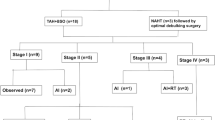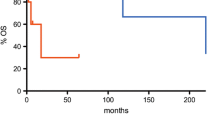Abstract
Objectives
The optimal approach in the management of endometrial stromal sarcoma (ESS) remains unclear. The aim of the present study was to retrospectively report the outcome of patients treated for ESS in our hospital over a 27-year period in order to evaluate the treatment results and the role of radiotherapy.
Patients and methods
From 1979 to 2006, 13 patients with ESS were treated at the Hospital Clínic of Barcelona. Patients underwent abdominal hysterectomy and bilateral salpingo-oophorectomy. The 1989 FIGO classification for endometrial carcinoma was used in this retrospective study. Seven patients presented stage I (6 IB and 1 IC), 1 stage II, 3 stage III and 2 stage IV. Nine patients had high-grade tumours with an infiltration of the outer 50% of the myometrium. Postoperative radiotherapy was administered in 10 patients.
Results
The mean follow-up of the patients was 54.6 months (range between 3 and 190). Patients with stage IB had a better outcome in comparison to more advanced stages. Five of the six patients with stage IB received adjuvant radiotherapy and none developed local recurrence, while one patient who received no treatment with radiotherapy had a relapse. Seven of the 13 patients had stages over IB: 5 who had received radiotherapy after surgery had locoregional control and 2 who did not receive radiotherapy had local relapse. Nine patients had high-grade tumours, 6 received radiotherapy after surgery and only one had local relapse. Of the three who did not receive radiotherapy, 2 relapsed locally. Local control rate of the patients who received adjuvant radiotherapy was higher than in the patients who did not (88.9% vs. 50%).
Conclusions
Our data reveal that deep myometrial invasion and stage over IB are significantly associated with poor overall survival and this finding is similar to those of studies in patients with endometrial cancer. The present study showed that the local control was higher in patients receiving radiotherapy.
Similar content being viewed by others
References
Reich O, Regauer S (2005) Endometrial stromal sarcoma-observational evidence of genetic background? Eur J Gynaecol Oncol 26:288–290
Tavassoli FA, Devilee P (eds) (2003) World Health Organization classification of tumours. Pathology and genetics of tumours of breast and female genital organs. IARC Press, Lyon
Pautier P, Genestie C, Rey A et al (2000) Analysis of clinicopathologic prognostic factors for 157 uterine sarcomas and evaluation of a grading score validated for soft-tissue sarcoma. Cancer 88:1425–1431
Mansi J, Ramachandra S, Wiltshaw E et al (1990) Case report: endometrial stromal sarcoma. Gynecol Oncol 36:113–118
Berchuck A, Rubin SC, Hoskins WJ et al (1990) Treatment of endometrial stromal tumors. Gynecol Oncol 36:60–65
Shepherd JH (1989) Revised FIGO staging for gynaecological cancer. Br J Obstet Gynaecol 96:889–892
Oliva E, de Leval L, Soslow RA et al (2007) Frequency of JAZF1-JJAZ1 gene fusion in endometrial stromal tumors with smooth muscle differentiation by interphase FISH detection. Am J Surg Pathol 31:1277–1284
Nordal RR, Kristensen GB, Kaern J et al (1996) The prognostic significance of surgery, tumor size, malignancy grade, menopausal status, and DNA ploidy in endometrial stromal sarcoma. Gynecol Oncol 62:254–259
Liokumovich P, Goldberg I, Davidson B et al (1999) Expression of metalloproteinases endometrial stromal sarcoma: immunohistochemical study using image analysis. J Clin Pathol 52:198–202
Chang KL, Crabtree GS, Lim-Tan SK et al (1990) Primary uterine endometrial stromal neoplasms. A clinicopathologic study of 117 cases. Am J Surg Pathol 14:415–438
Rovirosa A (2006) Tumores uterinos con componente sarcomatoso. Pasado, presente y futuro. Oncología 29:277–282
Rovirosa A, Ascaso C, Ordi J et al (2002) Is vascular and lymphatic space invasion a main prognostic factor in uterine neoplasms with sarcomatous component? A retrospective study of prognostic factors of 60 patients stratified by stages. Int J Radiat Oncol Biol Phys 52:1320–1329
Rovirosa A, Ascaso C, Ordi J et al (2009) How to deal with prognostic factors and radiotherapy results in uterine neoplasms with a sarcomatous component. Clin Transl Oncol 11:681–687
Bodner K, Bodner-Adler B, Obermair A et al (2001) Prognostic parameters in endometrial stromal sarcoma: a clinicopathologic study in 31 patients. Gynecol Oncol 81:160–165
Reed NS, Mangioni C, Malmstrom H et al (2003) First results of randomized trial comparing radiotherapy vs observation postoperatively in patients with uterine sarcomas. An EORTC GCG Study. Int J Gynecol Cancer 13:4. Abstract PL12
Salazar OM, Bonfiglio TA, Pattern SF et al (1978) Uterine sarcomas: natural history, treatment and prognosis. Cancer 42:1152–1160
Berchuck A, Rubin SC, Hoskins WJ et al (1990) Treatment of endometrial stromal tumors. Gynecol Oncol 36:60–65
Nola M, Babic D, Ilic J et al (1996) Prognostic parameters for survival of patients with malignant mesenchymal tumors of the uterus. Cancer 78:2543–2550
The National Cancer Institute. Available at: http://www.Cancer.gov/cancertopics/pdq/treatment/uterinesarcoma/HealthProfessional. Accessed 19 December 2006
The National Comprehensive Cancer Network (2006) Practice guidelines in oncology uterine sarcoma, v. 2. Available at: http://www.nccn.org/professionals/physician_gls/default.asp. Accessed 5 August 2006
Hachisuga T, Kaku T, Fukuda K et al (1999) The grading of lymphovascular space invasion in endometrial carcinoma. Cancer 86:2090–2097
Crisiano FD, Robboy SJ, Dodge RK et al (2000) The outcome of stage I-II clinically and surgically staged papillary serous and clear cell endometrial cancers when compared with endometrioid carcinoma. Gynecol Oncol 77:55–65
Fekete PS, Vellios F (1984) The clinical and histological spectrum of endometrial stromal neoplasms: a report of 41 cases. Int J Gynecol Pathol 3:198–202
Bal A, Mohan H, Aulakh R, Huria A (2008) Endometrial stromal lesions: a morphological and immunohistochemical study of short series. Arch Gynecol Obstet 277:21–24
Author information
Authors and Affiliations
Corresponding author
Rights and permissions
About this article
Cite this article
Valduvieco, I., Rovirosa, Á., Colomo, L. et al. Endometrial stromal sarcoma. Is there a place for radiotherapy?. Clin Transl Oncol 12, 226–230 (2010). https://doi.org/10.1007/s12094-010-0493-9
Received:
Accepted:
Published:
Issue Date:
DOI: https://doi.org/10.1007/s12094-010-0493-9




